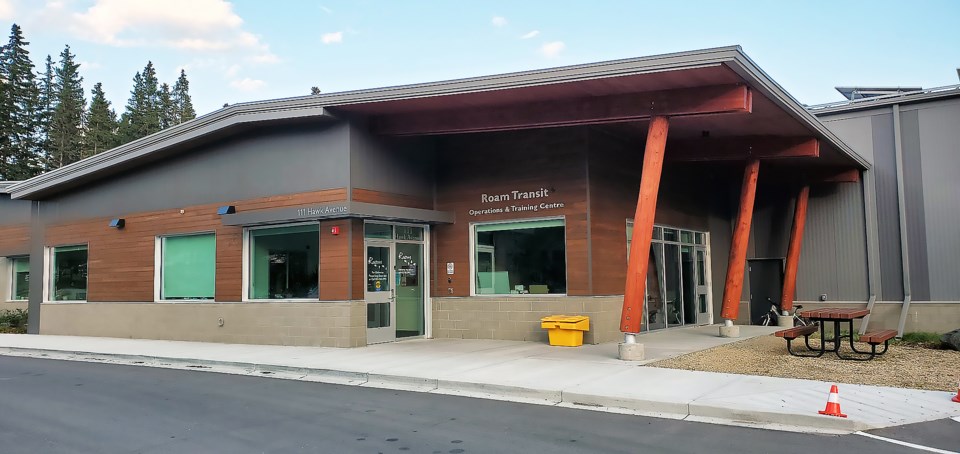BANFF – An ongoing staff shortage is driving the local transit commission to investigate staff accommodation options to attract and retain bus drivers.
Martin Bean, the chief administrative officer for Bow Valley Regional Transit Services Commission (BVRTSC), said Roam transit was short about 10 drivers this summer as ridership numbers for the peak season reached an all-time high.
“Something that’s been on our radar for a number of years, but we really have to move on, is investigating staff accommodation,” he said, noting the lack of drivers meant services were reduced and overtime was paid.
“If we had staff accommodation, we could likely have met the needs for this past summer. We’re going to need something for the upcoming summer just to attract enough people to move out here and drive as needed.”
Bean said the seasonal nature of the work makes it difficult to retain transit drivers, but he also noted that with commercial bus operators back up and running as the COVID-19 pandemic eased had an impact.
He said more drivers were keen to work for Roam in 2021 when commercial tour operators were not operating.
“We were able to attract a lot of drivers that would normally be at Pursuit or Traxx or other companies, and then they chose this year to go back to those companies,” he said, noting Roam doesn’t pay tips.
“That’s really the main difference between the two. Our compensation is good for drivers and it’s above a lot of those companies, but if you factor in gratuities, then they’re making quite a bit more.”
The staffing shortages meant Roam could not offer the level of service this year as previously planned.
Bean said that meant some of the Banff local routes, and in Lake Louise, could not handle the number of people wanting to catch buses at certain times of day.
“Primarily that four o’clock to 6:30 in the evening was where we saw the most challenges with capacity,” he said.
“We mitigated that throughout the summer with some better messaging and also we added a floater bus, wherever staffing made it possible, and it was often one of our dispatch staff would get in a bus about four o’clock and just go out to wherever the capacity was greatest and help.”
BVRTSC’s proposed 2023 requisition for the Town of Banff is $2.534 million. The Town of Canmore's requisition is $1.781 million, Park's Canada's is $1.663 million and ID No. 9's is $772,173.
Bean said five more electric buses will be added to the Roam fleet in January for 2023, including two for Banff locals routes and one to potentially add a route on Parks Canada transit services.
He said the plan for next summer in Banff is to have four buses operating on route 1 – Sulphur Mountain, Banff Avenue, gondola and hot springs – and three buses on route 2 – Tunnel Mountain, campgrounds, Banff Springs Hotel, with a frequency of 17 and 22 minutes.
“When you get to a frequency of 17 or even 22 minutes, people aren’t checking schedules very often. They just know there’s going to be a bus coming shortly,” he said.
“That’s pretty exciting and I think that will take care of a lot of the capacity issues we saw this summer just by having those extra buses on each route.”
Bean said he believes the additional two buses on the Banff local routes will be enough to satisfy the need for the upcoming year.
“But as we grow and as things change within the town as far as people wanting to visit, then we will be looking at growth and needing new buses with the next few years,” he said.
Coun. Hugh Pettigrew raised concerns with the ever increasing requisition for Roam.
“The City of Calgary just announced increases in fares,” he said.
“Does Roam not contemplate changing their rates to cover extra costs so that residents of Banff see a bit less of a requisition,” he said.
Bean said Roam has a commitment to do a fare review every five years, with the next one coming up in 2023 prior to budgeting for the following year.
“We’ll weigh the benefits of cost recovery versus ridership and reduction of congestion at that time,” he said.
Routes 1 and 2 have seen ridership above pre-pandemic 2019 levels, with about 880,000 riders so far this year.
Coun. Grant Canning, who is a Town of Banff representative on BVRTSC, said the ridership numbers this year show the value of Roam to the community and surrounding national park cannot be underestimated.
“For example, route 1 in the month of July had 100,000 people ride that bus. That’s the population of Lethbridge that is moving over a 30-day period,” he said.
“The overload situation was obviously concerning, but in my mind, we’re almost a victim of our own success. We’ve done really, really well in promoting the service and having people ride the service.”




